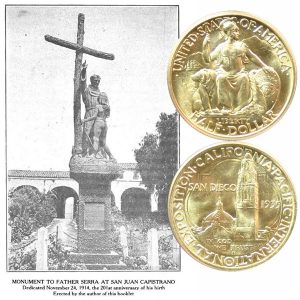Today, the California Pacific Commemorative Silver Half Dollar Coin remembers the second and official beginning of the Mission San Juan Capistrano on November 1, 1776.
From the guide booklet by St. John O’Sullivan titled Little Chapters About San Juan Capistrano, published in 1912:
=====
This Mission of San Juan Capistrano, with the little town bearing the same name, is situated in Orange County, California, fifty-six miles south of Los Angeles, on the Santa Fe Railway.
It stands about a mile above the confluence of two streams which flow through narrow valleys skirted by lomas, as the rather high and rounded hills are called by the people here, for Spanish is still the prevailing language of the place.
The stream from the north, which runs on the west side of the Mission, is the Trabuco, and that from the northeast, which comes down the Mision Vieja Cañon and crosses the Camino Real about a mile south of the Mission, is known as the San Juan.
Consequently the Mission stands between these two streams, so that its gardens, vineyards and orchards had a plentiful supply of water from both of them, partly by means of zanjas, or open ditches, and partly by underground waterways, fragments of which may still be seen leading from the separate streams.
The distance to the Pacific Ocean is about two and a half miles, and the opening formed by the valley at the Ocean is called La Boca de la Playa.
A few miles up the coast, there is a high cliff overlooking a narrow sandy beach. This spot was formerly called El Embarcadero Viejo, but from the circumstance of Richard H. Dana’s experience there, as described in his “Two Years Before the Mast,” when hides from the Mission were thrown over the cliffs to be brought out in small boats to the ships, the place has come to be known as “Dana’s Point.”
This region was formerly inhabited by Indians who called themselves Acagchemem, and the place Acagcheme.
Father Junipero Serra calls the place Quanís-savit, but this probably refers to the original location of the Mission, six miles up the Mision Vieja Canon.
When an Indian became formally associated with the Mission, which took place at his baptism, he came to be known as a San Juaneño or Mission Indian connected with San Juan Capistrano.
The Mission was named after San Juan Capistrano, or St. John, native of Capistrano, which is a town in the Abruzzi, in Italy.
Born in 1385, he became a Franciscan priest, and being noted for his zeal and eloquence, was chosen as preacher in the army of Hunyadi, and was present at the siege of Belgrade.
Consequently his statue in the Church of the Mission shows him in a semi-military habit. He died in 1456. There is another mission bearing his name near San Antonio, in Texas.
The first founding of this Mission took place on October 30, 1775, the octave of the feast of San Juan Capistrano, when mass was celebrated in a mere shelter of boughs, by Fray Fermin Francisco de Lasuen, who had come up from San Diego, accompanied by Lieut. José Francisco de Ortega, one sergeant, and a few soldiers.
Eight days afterwards, news arrived from San Diego of the destruction of the Mission there by the Indians, and giving orders to bury the bells, Fr. Lasuen returned to San Diego with Lieut. Ortega and his men.
Local tradition at San Juan says that this first founding took place six miles up the Mision Vieja Cañon, where the remains of a large building of adobes may still be seen.
The following year Father Serra with Fathers Amurrio and Mugartegui and eleven soldiers came from San Diego to begin again the work that had been interrupted, and finding the cross of the year before still standing, formally founded a second time the Mission on November 1, 1776, which thus became the seventh in order of establishment.
The first in Upper California was begun at San Diego, on July 16, 1769.
Father Serra then went to Mission San Gabriel to send cattle and neophytes to assist in the building of the Mission, but before leaving he made several entries in the record books of the new establishment.
The following is a translation of his entry in the record of deaths:
“Praised be Jesus, Mary and Joseph.
“In this book are the death entries of the Mission San Juan Capistrano, of Quanís-savit, belonging to the Apostolic College of San Fernando, Mexico, of missionaries of the Order of our holy Father, St. Francis, of the (regular) observance, founded by the religious of the said Apostolic College at the expense of the Catholic Monarch of the Spains and the Indies, Señor Don Carlos III, whom may God prosper many years;
“the funds supplied by order and direction of his Excellency, Señor Fray Don Antonio Maria Bucareli y Ursua, Knight and Baylio of the Order of St John, Lieut. General of the Royal Armies, Viceroy, Governor and Captain General of this New Spain, etc., and eminent promoter of these new establishments, begun on the most solemn day of All Saints, Nov. 1, 1776,
“on which I, the undersigned, president of these new missions of the infidels for the said Apostolic College, conjointly with the Father Procurator, Fray Gregorio Amurrio, having implored the divine aid and made the usual blessings of water, place, cross and bells, sang Mass and declared the mission as begun, for the administration of which I left assigned as its first ministers the Rev. Lector, Fray Pablo de Mugartegui and the aforementioned Father Procurator, Fray Gregorio de Amurrio, both of the holy province of Cantabria, and Preachers Apostolic of the aforesaid College of San Fernando, Mexico.
“Junipero Serra”
=====
The California Pacific Commemorative Silver Half Dollar Coin shows with an image of a monument honoring Father Serra, dedicated in 1914.
